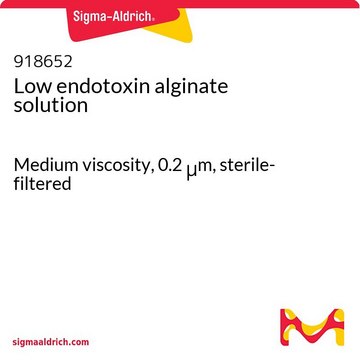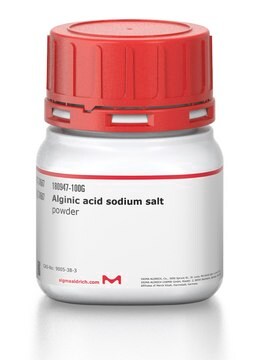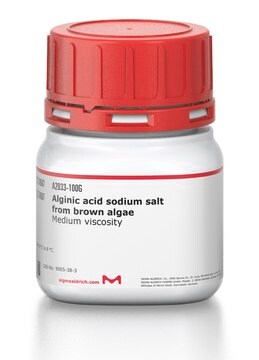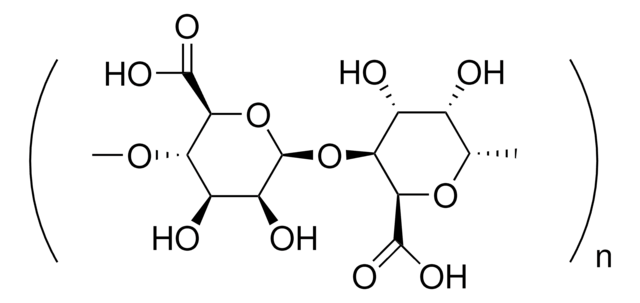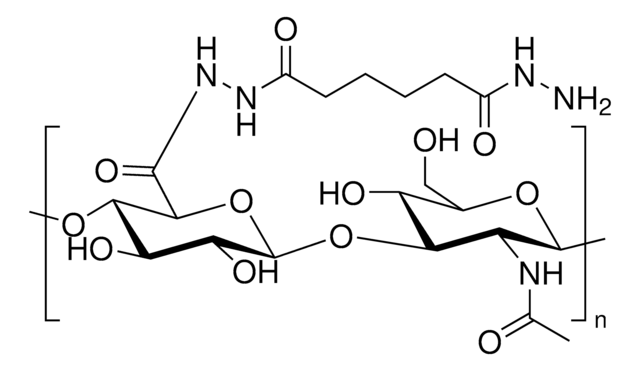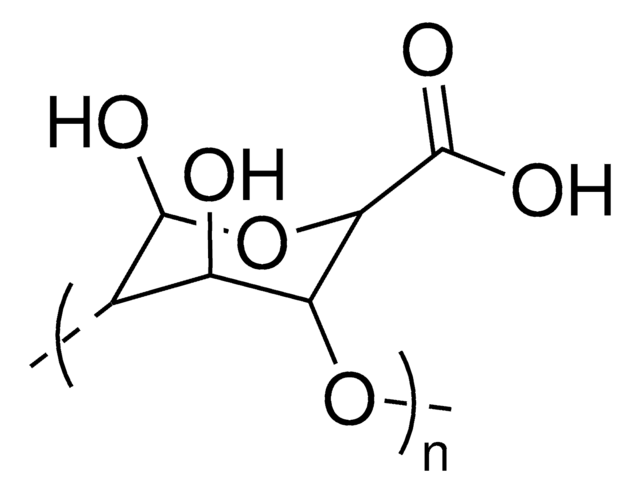919373
Low endotoxin alginate
Medium viscosity
Synonim(y):
Alginian sodu, Kwas alginowy
Zaloguj sięWyświetlanie cen organizacyjnych i kontraktowych
About This Item
Kod UNSPSC:
12352201
NACRES:
NA.23
Polecane produkty
Poziom jakości
Formularz
lyophilized powder
zanieczyszczenia
<10 CFU/g Bioburden
<100 EU/g Endotoxin
kolor
white to pale yellow
temp. przechowywania
2-8°C
Zastosowanie
Produkt ten jest wersją alginianu o niskiej zawartości endotoksyn, jest liofilizowanym proszkiem i jest gotowy do użycia w zastosowaniach biomedycznych.
Alginian jest anionowym polisacharydem, który jest szeroko stosowany w zastosowaniach farmaceutycznych i biomedycznych ze względu na jego niezwierzęce pochodzenie, niską toksyczność, biokompatybilność i biodegradowalność. Hydrożele alginianowe są powszechnie stosowane do wytwarzania rusztowań inżynierii tkankowej, biotuszów do biodruku 3D oraz nanonośników do dostarczania leków i genów. Alginian jest powszechnie sieciowany w hydrożel poprzez sieciowanie jonowe kationami dwuwartościowymi (np. Ca2+).
Alginian jest anionowym polisacharydem, który jest szeroko stosowany w zastosowaniach farmaceutycznych i biomedycznych ze względu na jego niezwierzęce pochodzenie, niską toksyczność, biokompatybilność i biodegradowalność. Hydrożele alginianowe są powszechnie stosowane do wytwarzania rusztowań inżynierii tkankowej, biotuszów do biodruku 3D oraz nanonośników do dostarczania leków i genów. Alginian jest powszechnie sieciowany w hydrożel poprzez sieciowanie jonowe kationami dwuwartościowymi (np. Ca2+).
Opakowanie
500 mg w szklanej butelce
Ta strona może zawierać tekst przetłumaczony maszynowo.
Kod klasy składowania
13 - Non Combustible Solids
Klasa zagrożenia wodnego (WGK)
WGK 2
Temperatura zapłonu (°F)
Not applicable
Temperatura zapłonu (°C)
Not applicable
Wybierz jedną z najnowszych wersji:
Certyfikaty analizy (CoA)
Lot/Batch Number
Nie widzisz odpowiedniej wersji?
Jeśli potrzebujesz konkretnej wersji, możesz wyszukać konkretny certyfikat według numeru partii lub serii.
Masz już ten produkt?
Dokumenty związane z niedawno zakupionymi produktami zostały zamieszczone w Bibliotece dokumentów.
Jia Jia et al.
Acta biomaterialia, 10(10), 4323-4331 (2014-07-08)
Recent advances in three-dimensional (3-D) printing offer an excellent opportunity to address critical challenges faced by current tissue engineering approaches. Alginate hydrogels have been used extensively as bioinks for 3-D bioprinting. However, most previous research has focused on native alginates
Kuen Yong Lee et al.
Progress in polymer science, 37(1), 106-126 (2011-11-30)
Alginate is a biomaterial that has found numerous applications in biomedical science and engineering due to its favorable properties, including biocompatibility and ease of gelation. Alginate hydrogels have been particularly attractive in wound healing, drug delivery, and tissue engineering applications
Tarun Agarwal et al.
ACS applied materials & interfaces, 8(47), 32132-32145 (2016-12-10)
Success of bone tissue engineering (BTE) relies on the osteogenic microarchitecture of the biopolymeric scaffold and appropriate spatiotemporal distribution of therapeutic molecules (growth factors and drugs) inside it. However, the existing technologies have failed to address both the issues together.
Eneko Axpe et al.
International journal of molecular sciences, 17(12) (2016-11-30)
Three-dimensional (3D) bioprinting is on the cusp of permitting the direct fabrication of artificial living tissue. Multicellular building blocks (bioinks) are dispensed layer by layer and scaled for the target construct. However, only a few materials are able to fulfill
Nasz zespół naukowców ma doświadczenie we wszystkich obszarach badań, w tym w naukach przyrodniczych, materiałoznawstwie, syntezie chemicznej, chromatografii, analityce i wielu innych dziedzinach.
Skontaktuj się z zespołem ds. pomocy technicznej